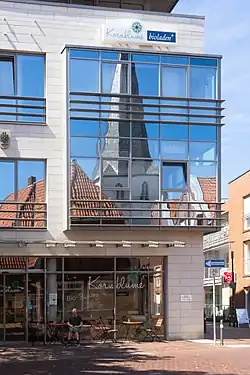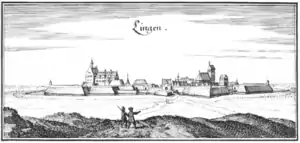Lingen, Germany
Lingen (German pronunciation: [ˈlɪŋən] ⓘ), officially Lingen (Ems), is a town in Lower Saxony, Germany. In 2008, its population was 52,353, and in addition there were about 5,000 people who registered the city as their secondary residence. Lingen, specifically "Lingen (Ems)"[3] is located on the river Ems in the southern part of the Emsland District, which borders North Rhine-Westphalia in the south and the Netherlands in the west.
Lingen (Ems) | |
|---|---|
 Reformed church mirrored in the Kornblume windows | |
_COA.png.webp) Coat of arms | |
Location of Lingen (Ems) within Emsland district _in_EL.svg.png.webp) | |
 Lingen (Ems)  Lingen (Ems) | |
| Coordinates: 52°31′23″N 7°19′23″E | |
| Country | Germany |
| State | Lower Saxony |
| District | Emsland |
| Government | |
| • Lord mayor (2018–23) | Dieter Krone[1] (Ind.) |
| Area | |
| • Total | 176.15 km2 (68.01 sq mi) |
| Elevation | 24 m (79 ft) |
| Population (2021-12-31)[2] | |
| • Total | 55,599 |
| • Density | 320/km2 (820/sq mi) |
| Time zone | UTC+01:00 (CET) |
| • Summer (DST) | UTC+02:00 (CEST) |
| Vehicle registration | EL |
| Website | lingen.de |
History

Lingen was first mentioned in the Middle Ages (975 AD). From 804 to 1180 the region was part of the Duchy of Saxony inside the Carolingian Empire, and then remained part of the german-speaking Holy Roman Empire until 1806. A initially independent county of Lingen (Grafschaft Lingen) was erected in 1388 and remained until 1713, when Prussia took over. In detail though, the county and city in the 17th and 18th were repeatedly conquered by Dutch and Spanish troops: initially Catholic, from 1541 to 1547 the citizens were forced to become Lutheran, then the troops of Catholic Charles V conquered the county and city and in 1550 gave it to his sister Mary, Governor of the Habsburg Netherlands. From 1555 to 1597 Lingen was the easternmost point of the Spanish Empire of Philip II and became part of the Eighty Years' War. From 1597 to 1605 Lingen was conquered by the Calvinist and Dutch Union of Utrecht, then retaken by the Catholic Spanish troops and from 1632 to 1672 again was part of the Calvinist Union of Utrecht. For two years the Prince-Bishopric of Münster had the city, which then from 1674 to 1713 was part of the Calvinist Union of Utrecht again, when Frederick I of Prussia inherited the county. From 1807 to 1813 the troops of Napoleon Bonaparte had the region, and from 1810 to 1813 Lingen was part of France. In 1814 it again was part of Prussia, and in 1815 became part of the newly founded kingdom of Hanover. As result of the Austro-Prussian War in 1866 the kingdom of Hanover and also Lingen were annexed by the kingdom of Prussia, and in 1871 became part of the German Empire.
Economy and education
Lingen is known for its offshore- and nuclear industry (Emsland Nuclear Power Plant). The University of Applied Sciences Osnabrueck has set up a branch campus, located in the centre of Lingen, with the three Institutes for Management and Engineering, Communications Management and Teaching of Theatre. In 2000 the institutes in Lingen merged into the Faculty of Society and Technology. In 2010 there are expected to be about 2,000 students attending.
Climate
On 25 July 2019, Lingen set the record for the hottest temperature ever recorded within Germany with a daytime high temperature of 42.6 degrees Celsius (109 degrees Fahrenheit) during a heat wave affecting much of Europe.
| Climate data for Lingen (1991–2020 normals) | |||||||||||||
|---|---|---|---|---|---|---|---|---|---|---|---|---|---|
| Month | Jan | Feb | Mar | Apr | May | Jun | Jul | Aug | Sep | Oct | Nov | Dec | Year |
| Average high °C (°F) | 5.1 (41.2) |
6.0 (42.8) |
9.8 (49.6) |
14.7 (58.5) |
18.7 (65.7) |
21.3 (70.3) |
23.6 (74.5) |
23.2 (73.8) |
19.5 (67.1) |
14.3 (57.7) |
9.1 (48.4) |
5.6 (42.1) |
14.3 (57.7) |
| Daily mean °C (°F) | 2.8 (37.0) |
3.1 (37.6) |
5.8 (42.4) |
9.8 (49.6) |
13.6 (56.5) |
16.3 (61.3) |
18.5 (65.3) |
18.0 (64.4) |
14.6 (58.3) |
10.3 (50.5) |
6.4 (43.5) |
3.4 (38.1) |
10.2 (50.4) |
| Average low °C (°F) | 0.4 (32.7) |
0.4 (32.7) |
2.3 (36.1) |
5.0 (41.0) |
8.6 (47.5) |
11.3 (52.3) |
13.8 (56.8) |
13.4 (56.1) |
10.6 (51.1) |
6.9 (44.4) |
3.8 (38.8) |
1.1 (34.0) |
6.5 (43.7) |
| Average precipitation mm (inches) | 68.6 (2.70) |
51.9 (2.04) |
53.9 (2.12) |
42.5 (1.67) |
58.2 (2.29) |
67.5 (2.66) |
82.4 (3.24) |
73.6 (2.90) |
71.7 (2.82) |
66.6 (2.62) |
65.9 (2.59) |
68.8 (2.71) |
771.5 (30.37) |
| Average precipitation days (≥ 1.0 mm) | 18.5 | 16.3 | 16.0 | 14.0 | 14.8 | 14.7 | 16.0 | 16.1 | 15.2 | 16.2 | 18.2 | 19.0 | 194.9 |
| Average snowy days (≥ 1.0 cm) | 4.3 | 3.7 | 1.4 | 0 | 0 | 0 | 0 | 0 | 0 | 0 | 0.5 | 4.1 | 14 |
| Average relative humidity (%) | 86.6 | 83.8 | 78.6 | 71.4 | 71.4 | 73.1 | 74.4 | 76.3 | 81.2 | 84.8 | 88.1 | 88.6 | 79.9 |
| Mean monthly sunshine hours | 47.4 | 65.9 | 117.1 | 163.2 | 195.6 | 195.0 | 202.0 | 184.4 | 136.3 | 102.0 | 53.0 | 43.9 | 1,515.8 |
| Source: World Meteorological Organization[4] | |||||||||||||
Twin towns – sister cities
 Bielawa, Poland
Bielawa, Poland Burton upon Trent, England, United Kingdom
Burton upon Trent, England, United Kingdom Elbeuf, France
Elbeuf, France Marienberg, Germany
Marienberg, Germany Salt, Spain
Salt, Spain
Transport
Notable people
- Eberhard von Danckelmann (1643–1722), Prime Minister of Brandenburg-Prussia from 1692 to 1697
- Theodorus Jacobus Frelinghuysen (c.1691–c.1747), German-American Dutch-Reformed minister and theologian
- Konrad Beckhaus (1821–1890), Protestant clergyman and botanist
- Joseph Rosemeyer (1872–1919), track cyclist, competed at the 1896 Summer Olympics
- Hermann Wilhelm Berning (1877–1955), Bishop of Osnabrück 1914–1955
- Herms Niel (1888–1954), composer of military songs and marches, lived and died there
- Bernd Rosemeyer (1909–1938), racing car driver
- Harry Kramer (1925–1997), sculptor, choreographer, dancer and professor of art
- Beatrix Borchard (born 1950), musicologist and author
- Peter van Roye (born 1950), rower
- Wilfried Telkämper (born 1953), MEP, Vice President of the European Parliament 1989–1992
- Reinhold Hilbers (born 1964), politician (CDU)
- Jens Gieseke (born 1971), politician (CDU), Member of the European Parliament
- Christian Drosten (born 1972), virologist
- Ingo Schultz (born 1975), 400 metres runner
- Michael Rensing (born 1984), footballer
References
- "Verzeichnis der direkt gewählten Bürgermeister/-innen und Landräte/Landrätinnen". Landesamt für Statistik Niedersachsen. April 2021.
- "LSN-Online Regionaldatenbank, Tabelle A100001G: Fortschreibung des Bevölkerungsstandes, Stand 31. Dezember 2021" (in German). Landesamt für Statistik Niedersachsen.
- "Archived copy" (PDF). Archived from the original (PDF) on 2007-09-27. Retrieved 2006-12-26.
{{cite web}}: CS1 maint: archived copy as title (link), - "World Meteorological Organization Climate Normals for 1991–2020". World Meteorological Organization Climatological Standard Normals (1991–2020). National Oceanic and Atmospheric Administration. Archived from the original on 12 October 2023. Retrieved 12 October 2023.
- "Die Partnerstädte der Stadt Lingen (Ems)". lingen.de (in German). Lingen (Ems). Retrieved 2021-02-19.
External links
- Official website
 (in German)
(in German) - students website (in German)